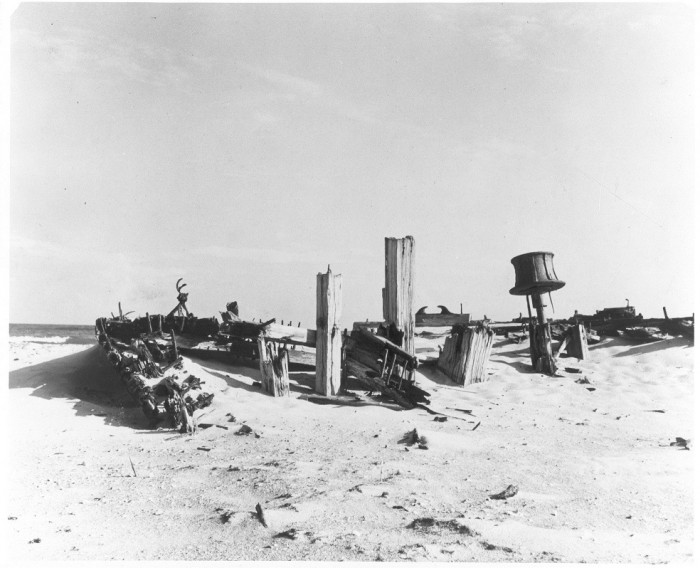On morning watch, Cape Hatteras Coast Guard surfman, C.P. Brady was looking seaward through the morning mist when appeared a tremendous ship laying motionless in the vast sea. The surfman immediately notified the Creed Hill and Big Kinnakeet Coast guard stations. They collectively gathered on the beach with there surfboats, struggling to make way past the breakers, they manages to bring two surfboats only to within a half-mile of the ship, too far away to read her name. All anyone could see was that she was shoaled in “a Boiling Bed of Breakers,” as Big Kinnakeet’s keeper C.R. Hooper, would later put it.
It was not until Friday on the 35th day of the year 1921, that the United States Coast Guard were able to reach the 255′ five masted schooner Carroll A. Deering with all sails set, flogging, hard aground on Diamond Shoals. Waters swirling and boiling all around her in the treacherous waters off Cape Hatteras, North Carolina the “Graveyard of the Atlantic.”
As the coast guard boarded the vessel they noticed that red lights were run up the mast suggesting that somebody wanted to signal that help was required. Ropes used for launching the lifeboats were hanging empty from both sides of the ship. When the Captains stateroom was inspected, several pairs of boots were found, indicating that the room was used by several persons at the end. As the search continued below deck, the ships galley showed evidence that a meal was about to be prepared. Upon entering the crews quarters all personal effects were gone, along with the ships navigational equipment, log books, and all eleven crew members of the vessel.
In 1919 the vessel was launched and christened, after the owners son, Carroll A. Deering. The last of many great schooners built for the G.G. Deering Company of Washington Street, Bath, Maine for commercial use. The vessel was designed to carry cargo and had been in service for a year when it began its final voyage to Rio de Janeiro, Brazil.

The ship was captained by co-owner William H. Merritt with his 29 year old son as first mate, and nine Scandinavians as the remaining members of the crew.
In late August of 1921 the vessel was scheduled to pick up coal in Norfolk, Virginia, then on to Rio to unload the coal and return to Maine. After having left Boston the captain fell seriously ill, and could not continue with his duties. The vessel made port at Lewes, Delaware, where both the captain and his son left the ship.
The Deering Company hired a replacement, a 66 year old retired veteran Captain W.B. Wormell, with Charles B. Mclellan as first mate. Setting sail without further delay, the vessel arrived in Rio on September 8, 1921.
After reaching there destination the captain offered leave to his entire crew. Later Captain Wormell met up with his old friend Captain Goodwin, Wormell mentioned to Goodwin that his first mate was useless trouble maker, and that his engineer, Herbert Bates, was a trusted efficient man. A person that could be relied on in case of an emergency.
After having left Rio on the 2nd of December 1921, for there return trip, they made port in Barbados for supplies. Here there first mate Mclellan got drunk in a cafe, complained about his captain, saying that he had to do all of the navigation, and had to control the restless crew, and shouting that he wanted to kill his captain. Mclellan was arrested and put behind bars. Captain Wormell pleaded for his release, was successful and on January 9th, 1921, the vessel set sail again for Portland, Maine.
On January 28th the ship was spotted by the Lightship Cape Lookout, anchored off the North Carolina coast. The commander of the lightship Jacobson heard one of the crewman, who did not look like the captain or first mate, shout out that they had lost there anchors, and that needed to be reported to the ships owners. Also it was noted that there were several other crewman gathered in the restricted space of the foredeck.

Soon thereafter another ship passed the lightship, a steamer ship with no name. Jacobson blew the powerful whistle, which required ships to check in, they did not and the ship continued on the same direction as the Deering, two days later she was hard aground on Diamond Shoals.
As of this day no cause has been discovered as to what became of the vessel, the Carroll A. Deering, and remains one of the biggest maritime mysteries of all time.

